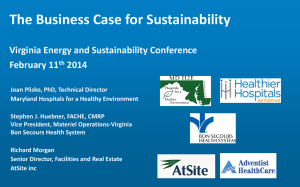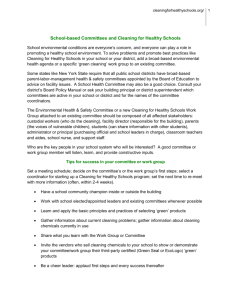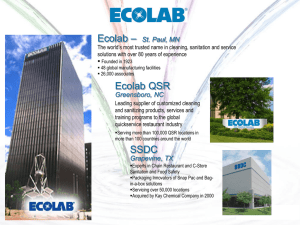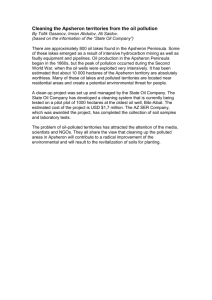Policy ADG - Sustainability - Baltimore City Public School System
advertisement
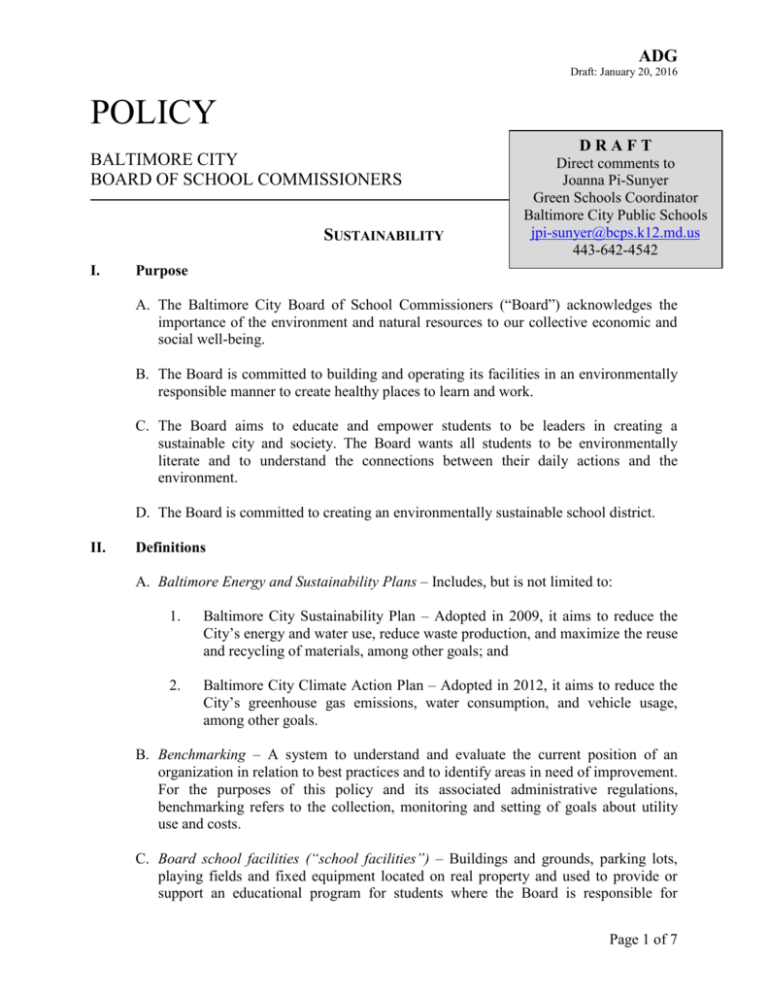
ADG Draft: January 20, 2016 POLICY BALTIMORE CITY BOARD OF SCHOOL COMMISSIONERS SUSTAINABILITY I. DRAFT Direct comments to Joanna Pi-Sunyer Green Schools Coordinator Baltimore City Public Schools jpi-sunyer@bcps.k12.md.us 443-642-4542 Purpose A. The Baltimore City Board of School Commissioners (“Board”) acknowledges the importance of the environment and natural resources to our collective economic and social well-being. B. The Board is committed to building and operating its facilities in an environmentally responsible manner to create healthy places to learn and work. C. The Board aims to educate and empower students to be leaders in creating a sustainable city and society. The Board wants all students to be environmentally literate and to understand the connections between their daily actions and the environment. D. The Board is committed to creating an environmentally sustainable school district. II. Definitions A. Baltimore Energy and Sustainability Plans – Includes, but is not limited to: 1. Baltimore City Sustainability Plan – Adopted in 2009, it aims to reduce the City’s energy and water use, reduce waste production, and maximize the reuse and recycling of materials, among other goals; and 2. Baltimore City Climate Action Plan – Adopted in 2012, it aims to reduce the City’s greenhouse gas emissions, water consumption, and vehicle usage, among other goals. B. Benchmarking – A system to understand and evaluate the current position of an organization in relation to best practices and to identify areas in need of improvement. For the purposes of this policy and its associated administrative regulations, benchmarking refers to the collection, monitoring and setting of goals about utility use and costs. C. Board school facilities (“school facilities”) – Buildings and grounds, parking lots, playing fields and fixed equipment located on real property and used to provide or support an educational program for students where the Board is responsible for Page 1 of 7 ADG Draft: January 20, 2016 maintenance, utilities (such as gas, fuel oil, steam, water, sewage, electricity and trash removal) or any additional operating cost. D. Conservation – The careful use, management, and protection of natural resources and the environment to prevent depletion, pollution, and waste. E. Council of Great City Schools – A nonprofit membership organization of large urban school districts, of which Baltimore City Public Schools is a member. The organization tracks Key Performance Indicators (KPIs) of its members. F. Energy – For the purposes of this policy and its associated administrative regulations, energy consists of electricity, fuel oil #2, natural gas, steam and renewable sources such as solar. G. ENERGY STAR – A program of the US Environmental Protection Agency that certifies products as being energy efficient and thereby helps save money and protect the climate through superior energy efficiency. H. Energy Use Intensity (EUI) – A measure of a facility’s energy use per square foot per year, which allows facilities of different sizes using different energy types to be compared. It is calculated by dividing the total energy consumed by the facility in one year, measured in kBtus (British thermal units) or GJs (billion joules), by the total gross floor area of the building. I. Environmental literacy – The ability of persons to implement the critical thinking, problem-solving, and decision-making skills to make informed and responsible decisions about resources and the environment. J. Environmentally preferable purchasing and management practices – An approach to using and reusing materials more productively over their entire life cycles, including raw material acquisition, production, use/reuse/maintenance, and end of life management. This approach seeks to use materials in the most productive way with an emphasis on using less, reusing items whenever possible, eliminating to the extent practicable the use of toxic chemicals, and reducing materials’ environmental impact, in an effort to ensure City Schools has sufficient resources to meet present and future needs. K. Environmental product and service label standards – Labels for products and services that were developed and awarded by an impartial third-party, were developed in a public and transparent process, and that use specific and meaningful criteria. L. Green – A generic term that applies to products and practices that protect both the environment and human health. Page 2 of 7 ADG Draft: January 20, 2016 M. Green school – A school building or facility that provides a healthy environment conducive to learning while saving energy, resources and money, and promotes Environmental Literacy. N. Green cleaning program – The practice of using green cleaning supplies and practices that, at minimum, comply with the Maryland Green Cleaning Law and that protect indoor air quality, human health and the environment. O. Green cleaning supplies – Products and equipment intended for routine cleaning and building maintenance that have reduced effects on human health and the environment compared to competing products that serve the same purpose. Many are certified to contain low–toxicity levels and biodegradable, or have a low volatile organic compound (VOC) content, reduced packaging, and/or low lifecycle energy use as well as positive product performance. Green Cleaning Supplies include, but are not limited to: 1. Recycled-content or compostable bags and liners; 2. Certified low-toxicity cleaning chemicals; 3. Certified low-toxicity floor maintenance products; 4. Certified low-toxicity hand soaps devoid of antibacterial ingredients; 5. High performance janitorial equipment (e.g. microfiber mops), and powered equipment (floor polishers); 6. Recycled-content janitorial paper products and high-efficiency hand dryers; and, 7. Non-toxic cleansing wipes. and 8. Sanitizers and disinfectants – due to their ability to kill pathogens, these typically are not certified as green; however, less-toxic yet still effective products exist. P. Green Seal – A green product labeling program for cleaning products, hand soaps, floor maintenance chemicals, janitorial paper products and other items, operated by a non-profit organization. It is an acceptable standard under the Maryland Green Cleaning Law. Q. Key Performance Indicators (KPIs) – A system for an organization to define and measure goals and achievements. The Council of Great City Schools establishes energy, water and waste KPIs for schools. Page 3 of 7 ADG Draft: January 20, 2016 R. Leadership in Energy & Environmental Design (LEED) – A green building certification program that recognizes building strategies and practices. Building projects must meet required and optional design, construction and operation items to earn points, thus achieving different levels of certification (Certified, Silver, Gold or Platinum). S. Maryland Energy laws – Includes, but is not limited to, EmPOWER Maryland Energy Efficiency Act of 2008, Greenhouse Gas Emissions Reduction Act of 2009, the Renewable Energy Portfolio Standards, and the Maryland High Performance Building Act of 2008. T. Maryland Environmental Literacy Standards – A state law that requires Local Education Authorities to incorporate eight environmental education standards into their curricula, and a related law that requires students graduating high school in 2015 or later to be environmentally literate. The standards are: Environmental Issues; Interactions of Earth’s Systems; Flow of Matter and Energy; Populations, Communities and Ecosystems; Humans and Natural Resources; Environmental Health; Environment and Society; Sustainability. U. Maryland Green Cleaning law – A state law that requires county boards of education to write policies and guidelines on the procurement of green cleaning supplies that: require the use of supplies that meet nationally-recognized environmental certification requirements; establish green cleaning practices (including storage, application, frequency of use, and disposal of supplies) to ensure that school building occupants do not suffer any adverse health effects as the result of these practices; and require staff training on implementing the policy. V. Maryland Engine Idling Law – A state law that states a motor vehicle may not be allowed to idle for more than five consecutive minutes when the vehicle is not in motion, with the following exceptions: the vehicle is stopped due to traffic conditions or mechanical difficulties; the engine is operating heating cooling or auxiliary equipment, to bring the engine to the manufacturer’s recommended operating temperature; or to accomplish the intended use of the vehicle. W. Maryland Recycling law – A state law that requires every county in the state, including the City of Baltimore, to develop a recycling strategy for its schools. X. Recycling – Recycling is the process of collecting and processing materials that would otherwise be thrown away as trash and turning them into new products. In Baltimore, many items may be co-mingled (paper, cardboard, glass, plastic, metal) and others should be separated (light bulbs, electronics). Y. Renewable energy – Energy which is regularly replenished, such as solar, wind, waves and geothermal heat, in contrast to non-renewable energy such as fossil fuels, which draw on finite resources that will eventually dwindle and become too expensive or too environmentally damaging to retrieve. Page 4 of 7 ADG Draft: January 20, 2016 Z. Safer Choice – A green product labeling program for cleaning products, hand soaps and other items, operated by the US Environmental Protection Agency. It covers cleaning, floor maintenance products, hand soaps, and de-icing chemicals. It is an acceptable standard under the Maryland Green Cleaning Law. Prior to 2015, the name was Design for the Environment. AA. Sustainability – An approach to living whereby the needs of the current generation are met without compromising the ability of future generations to meet their own needs, as defined by the Brundtland Commission of the United Nations in 1987. BB. Sustainability captain – A school-based staff person designated by each principal by September 30 of each school year to oversee sustainability efforts at the school. CC. Toxic chemicals –Substances that can cause adverse health effects such as asthma, cancer, reproductive harm in humans or other animals if they are inhaled, ingested, or absorbed through the skin. DD. UL EcoLogo – A green product labeling program for cleaning products, hand soaps, floor maintenance chemicals, and other items. It is an acceptable standard under the Maryland Green Cleaning Law. EE. III. WaterSense – A green product labeling program for water-using devices (faucets, toilets, etc.), operated by the US Environmental Protection Agency. Policy Standards A. City Schools shall develop a sustainability plan that includes, but is not limited to: 1. Energy and resource conservation management; 2. Environmentally preferable purchasing and management practices; 3. Green building design, construction, and operations; 4. Green cleaning; 5. Healthy indoor air quality; 6. Healthy food and nutrition service and education; 7. Integrated pest management (IPM); 8. Partnership cultivation; Page 5 of 7 ADG Draft: January 20, 2016 9. Student environmental literacy; and 10. Waste management (prioritizing waste reduction, the reuse and recycling of materials, and composting), and proper disposal. B. Applicability. This policy and its associated administrative regulations shall apply to every school, be it a traditional school, charter school, contract school or other kind of school in a board school facility or in a facility that its owns or leases, unless otherwise noted. IV. Implementation Strategies The CEO may elect to form a Sustainability Steering Committee to assist with the implementation of this policy. V. Compliance The CEO/designee shall submit an annual report to the Board by December 15. The report will include information regarding successes and challenges in implementing this policy. The report will also be made available on the City Schools website. VI. Legal and Policy References A. Legal Authority §2-1201 through §2-1211, Md. Code Ann., Environment; §3-602, §3-602.1, Md. Code Ann, State Finance and Procurement; §5-122(e), Md. Code Ann., Education; §5-301, 5-312, Md. Code Ann., Education §7-211, Md. Code Ann., Public Utilities; §7-701(i), Md. Code Ann., Public Utilities; §9-1703 Md. Code Ann., Environment; §22-402 Md. Code Ann. Transportation COMAR 13A.03.02; COMAR 13A.04.17, Baltimore City Sustainability Plan of 2009 Baltimore City Climate Action Plan of 2012 B. Policy References Related Board Policies: ADF, DJA, FKA, IHB C. Administrative Regulation References ADG-RA, ADG-RB, ADG-RC, DJA-RA Page 6 of 7 ADG Draft: January 20, 2016 Policy History: Page 7 of 7


